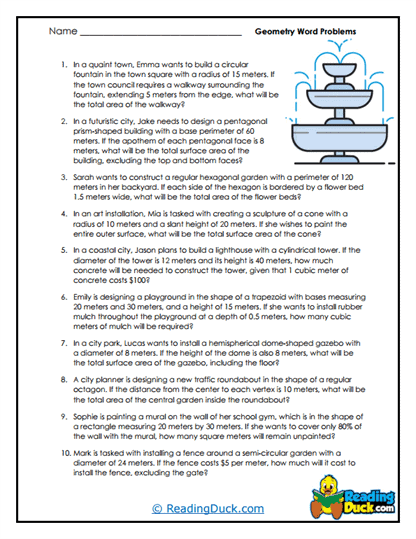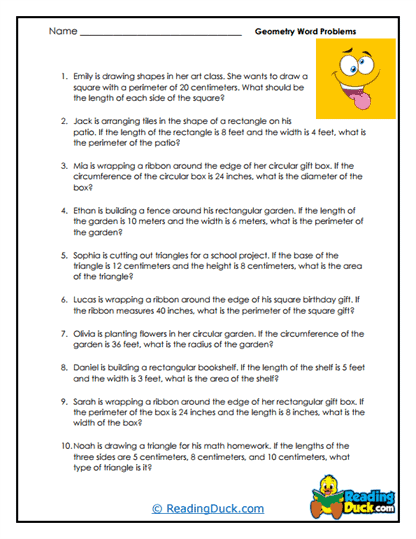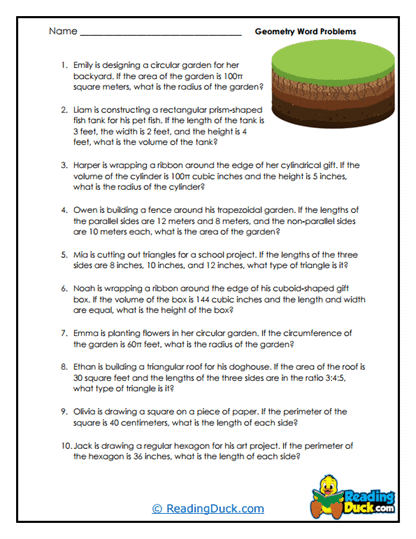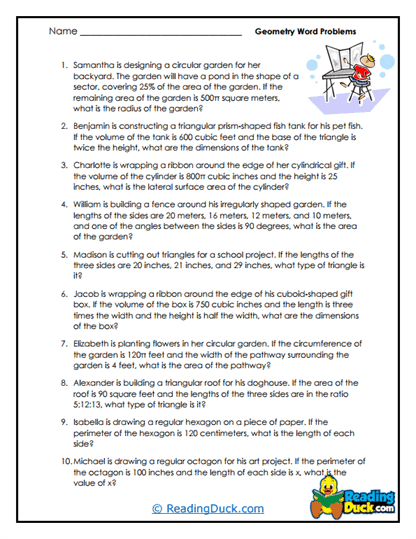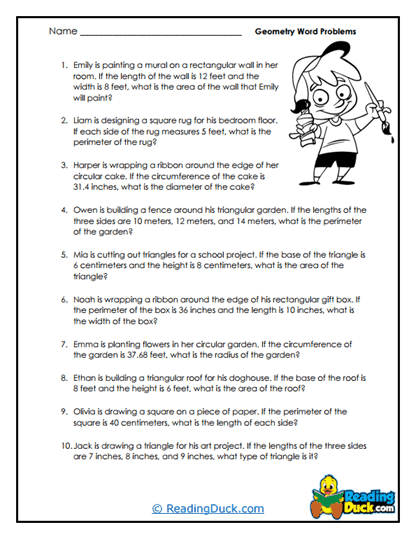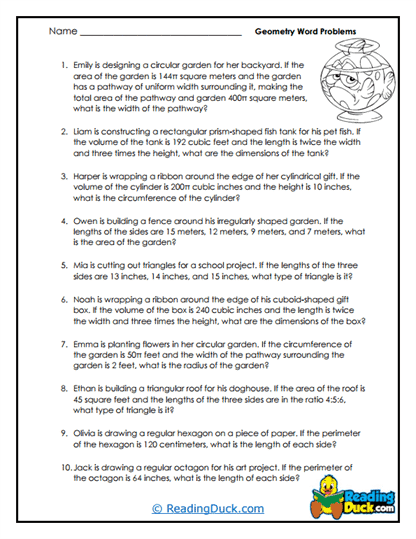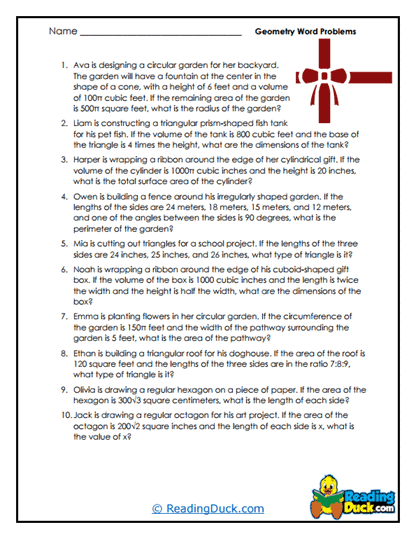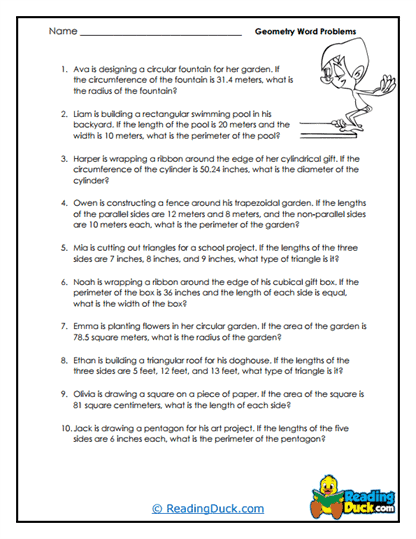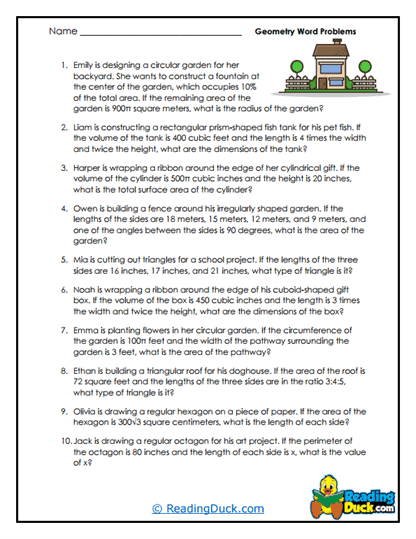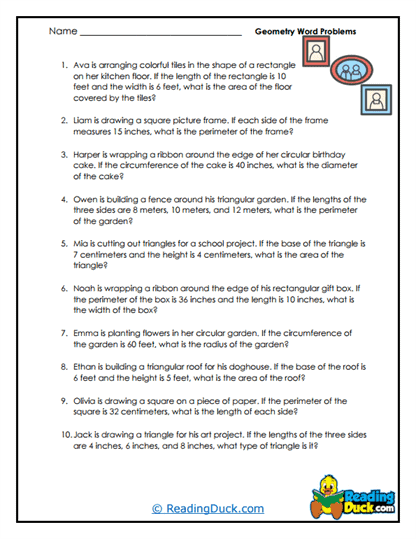Geometry Word Problems Worksheets
About Our Geometry Word Problem Worksheets
Our collection of Geometry Word Problems worksheets offers students an engaging and practical approach to applying geometric concepts in real-world scenarios. These worksheets fall under the subtopic of Word Problems within the broader category of Math. They are designed to help students not only master geometry but also enhance their reading comprehension and critical thinking skills by presenting problems that connect math to everyday life.
Each worksheet set includes:
- Multiple Choice Questions: These questions help students practice identifying and solving geometry problems by selecting the correct answer from a list of options, reinforcing their understanding of geometric concepts in different contexts.
- Short Answer Questions: In this section, students are encouraged to write their own answers, explaining their reasoning and solidifying their understanding of how to approach geometry word problems.
- Open-Ended Questions: These questions prompt students to provide personal input, opinions, or reflections related to the scenarios in the word problems. This format encourages students to connect geometric concepts to their own experiences, making the learning process more relatable and engaging.
Each worksheet comes with an answer key, making it easy for teachers and parents to review and assess students' work. All worksheets are available as PDF files, which can be easily viewed electronically, downloaded, and printed out for classroom or homeschool use.
Exploring Geometry: Understanding the Shapes and Spaces Around Us
Geometry is a branch of mathematics that deals with shapes, sizes, relative positions of figures, and the properties of space. Geometry word problems take these abstract concepts and apply them to practical, real-world situations, helping students see the relevance of geometry in everyday life. When introducing geometry word problems, it’s essential to explain the concepts in a clear and engaging way that connects the math to the physical world around us.
What Are Geometry Word Problems?
Geometry word problems are mathematical exercises that involve solving problems related to shapes, sizes, areas, volumes, angles, and other geometric concepts. These problems are presented in the form of a story or scenario, requiring students to apply their knowledge of geometry to find a solution. By framing geometry in real-world contexts, these word problems help students understand the practical applications of geometric principles.
Why Are Geometry Word Problems Important?
- Real-World Application: Geometry is all around us, from the design of buildings and furniture to the layout of cities and the natural world. Geometry word problems show students how these mathematical concepts are used in everyday situations, making the math more tangible and relevant. Understanding geometry is essential for fields such as architecture, engineering, art, and many other professions.
- Developing Spatial Awareness: Geometry helps students develop spatial awareness, which is the ability to understand and manipulate shapes and spaces in their mind. This skill is crucial not only in math but also in activities like drawing, building, and navigating through physical spaces. Geometry word problems challenge students to visualize shapes and spaces, enhancing their ability to think in three dimensions.
- Enhancing Problem-Solving Skills: Solving geometry word problems requires students to think critically about how to approach a problem, analyze the given information, and apply geometric principles to find a solution. This process strengthens their problem-solving skills, which are valuable in both academic and real-world contexts.
Key Concepts in Geometry Word Problems
- Understanding Shapes and Properties: The foundation of geometry lies in understanding different shapes and their properties. Students must be familiar with basic geometric shapes (such as triangles, squares, circles) and more complex ones (like polygons and polyhedrons). Knowing the properties of these shapes, such as angles, sides, and symmetry, is crucial for solving geometry word problems.
- Calculating Area and Perimeter: Many geometry word problems involve finding the area and perimeter of various shapes. Students need to understand the formulas for calculating the area (such as length × width for rectangles or πr² for circles) and perimeter (the total distance around a shape) and apply these formulas to real-world scenarios.
- Working with Volume and Surface Area: For three-dimensional shapes, students often need to calculate volume (the amount of space inside a shape) and surface area (the total area of all the surfaces of a shape). Problems may involve finding the volume of a box, the surface area of a cylinder, or the space inside a sphere.
- Understanding Angles and Their Relationships: Geometry also involves working with angles, including identifying different types of angles (acute, obtuse, right) and understanding the relationships between them (such as complementary and supplementary angles). Students may be asked to find missing angles in a figure or determine how angles relate to each other in different shapes.
- Applying the Pythagorean Theorem: The Pythagorean theorem is a fundamental concept in geometry, used to find the length of the sides of a right triangle. Students must understand how to apply this theorem to solve problems involving right triangles, whether in two-dimensional or three-dimensional contexts.
Common Scenarios in Geometry Word Problems
- Design and Architecture: Problems might involve calculating the area of a floor plan, determining the amount of paint needed for a wall, or figuring out the dimensions of a piece of furniture. These scenarios show how geometry is used in designing and constructing buildings and objects.
- Measurement and Conversion: Some problems require students to measure lengths, areas, or volumes and convert between different units. For example, students might be asked to convert the dimensions of a plot of land from feet to meters before calculating the area.
- Navigation and Mapping: Geometry is also used in navigation and mapping, such as calculating the shortest distance between two points (using the Pythagorean theorem) or finding the angle of elevation when looking up at an object from a distance.
Creative Ideas for Using Geometry Word Problems Worksheets
Teachers and parents can use these Geometry Word Problems worksheets in various creative and effective ways to enhance students' learning experiences. Here are some ideas on how to incorporate these worksheets into your educational curriculum:
1. Integrating Geometry with Real-Life Applications
- Practical Geometry Projects: Encourage students to apply their geometry skills to real-world projects, such as designing a garden layout, creating a blueprint for a simple structure, or planning the dimensions of a room. These projects help students see the practical applications of geometry and make the learning process more engaging and hands-on.
- Cross-Curricular Connections: Use geometry word problems to connect math with other subjects, such as art, science, or geography. For example, students can explore geometric patterns in art (like tessellations), calculate the angles and distances in scientific diagrams, or analyze the shapes and areas of different countries on a map. This approach reinforces geometric concepts while showing students how geometry is interconnected with other areas of knowledge.
2. Group Activities and Collaborative Learning
- Pair Work: Have students work in pairs to solve geometry word problems. One student can draw the shapes or diagrams while the other calculates the measurements or angles. This collaborative approach encourages communication, teamwork, and allows students to learn from each other's strengths.
- Math Centers: Set up a math center in your classroom where students can work on geometry word problems independently or in small groups. Provide manipulatives like geometric shapes, rulers, protractors, and graph paper to help them visualize and solve the problems. This hands-on approach is particularly beneficial for visual and kinesthetic learners who need to see and touch to understand.
3. Real-Life Projects and Applications
- Geometry in Architecture: Have students explore the role of geometry in architecture by analyzing famous buildings and structures. They can calculate the area, perimeter, or volume of different parts of the buildings, or examine the symmetry and shapes used in the design. This project helps students see the relevance of geometry in the built environment and understand how math is used in real-world professions.
- Field Trip Geometry: If you take your students on a field trip, incorporate geometry word problems related to the trip. For example, if you visit a museum or historical site, students could calculate the dimensions of a room, the area of a garden, or the angles in a structure. This makes math learning more dynamic and tied to real-world experiences, helping students see the relevance of geometry outside the classroom.
4. Personalized Learning and Differentiation
- Tailored Problems: Customize the geometry word problems to match the individual needs and abilities of your students. For struggling learners, simplify the problems by using basic shapes and straightforward scenarios. For advanced learners, increase the complexity by introducing multi-step problems or additional variables. Differentiating the worksheets ensures that all students are appropriately challenged and engaged at their level.
- Student-Created Problems: Encourage students to write their own geometry word problems based on their interests and experiences. They can then exchange problems with classmates to solve. This not only makes learning more personalized and relevant but also helps students take ownership of their math practice. It’s a great way to deepen their understanding by seeing how geometry applies to their own lives.
By using these Geometry Word Problems worksheets creatively, teachers and parents can help students develop a solid foundation in geometry while also enhancing their problem-solving abilities, spatial awareness, and real-world application of math. These worksheets are not just about practicing geometry; they are about making geometry a meaningful and engaging part of students' everyday lives. Through real-world scenarios and interactive learning approaches, students can see the practical applications of their mathematical knowledge, building confidence and enthusiasm for math.
